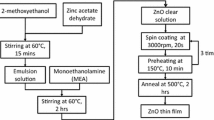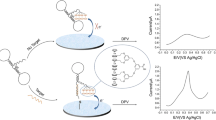Abstract
In this paper, a novel electrochemical sensor was developed for the rapid detection of G-G mismatched DNA based on hexaammineruthenium(III) chloride ([Ru(NH3)6]Cl3) as a redox indicator. The sensor platform was constructed by immobilizing small molecules (NC-linker) on the gold electrode via amide bonds. The as-prepared NC-linker as the nucleic acids recognition molecule can interact with the G base of DNA. After the sensor was incubated with G-G mismatched DNA, the double-stranded DNA (dsDNA) acted as carriers of the signal tags-[Ru(NH3)6]Cl3, which resulted in a remarkable electrochemical signal. More binding of [Ru(NH3)6]Cl3 led to increases of the electrochemical signal. Other mismatched DNA produced only a low response, as well as complementary DNA. Thus G-G mismatched DNA can be easily discriminated from other mismatched and complementary DNA based on the sensor. Furthermore, the method was simple, rapid and repeatable for the detection of G-G mismatched DNA. The selective detection of target dsDNA was achieved by a relative current ratio of the target and control DNA. These results demonstrated that this strategy could provide great promise for the rapid and specific detection of other sequence-specific DNA.
Similar content being viewed by others
References
R. Mayr, M. Haider, R. Thünauer, T. Haselgrübler, G. J. Schütz, A. Sonnleitner, and J. Hesse, Biosens. Bioelectron., 2016, 78, 1.
Y. Teng, X. F. Jia, S. Zhang, J. B. Zhu, and E. Wang, Chem. Commun., 2016, 52, 1721.
A. A. Lubin and K. W. Plaxco, Acc. Chem. Res., 2010, 43, 496.
E. E. Ferapontova, E. M. Olsen, and K. V. Gothelf, J. Am. Chem. Soc., 2008, 130, 4256.
J. Zhang, S. P. Song, L. Y. Zhang, L. H. Wang, H. P. Wu, D. Pan, and C. H. Fan, J. Am. Chem. Soc., 2006, 128, 8575.
H. Xie, C. Y. Zhang, and Z. Q. Gao, Anal. Chem., 2004, 76, 1611.
R. Y. La, K. W. Plaxco, and A. J. Heeger, Anal. Chem., 2007, 79, 229.
A. Mugweru and J. F. Rusling, Anal. Chem., 2002, 74, 4044.
E. V. Suprun, S. A. Khmeleva, S. P. Radko, S. A. Kozin, A. I. Archakov, and V. V. Shumyantseva, Electrochem. Commun., 2016, 65, 53.
A. M. Oliveira-Brett, L. A. D. Silva, and C. M. A. Brett, Langmuir, 2002, 18, 2326.
K. Fricke, F. Harnisch, and U. Schröder, Energy Environ. Sci., 2008, 1, 144.
C. M. Ruan, L. J. Yang, and Y. B. Li, Anal. Chem., 2002, 74, 4814.
K. Nakatani, S. Sando, and I. Saito, Nat. Biotechnol., 2001, 19, 51.
J. Li, H. P. He, X. Q. Peng, M. Huang, X. H. Zhang, and S. F. Wang, Anal. Sci., 2015, 7, 663.
H. P. He, J. P. Xia, G. Chang, X. Q. Peng, Z. W. Lou, K. Nakatani, X. Zhou, and S. F. Wang, Biosens. Bioelectron., 2013, 42, 36.
H. P. He, J. P. Xia, X. Q. Peng, G. Chang, X. H. Zhang, Y. F. Wang, K. Nakatani, Z. W. Lou, and S. F. Wang, Biosens. Bioelectron., 2013, 49, 282.
H. P. He, X. Q. Peng, M. Huang, G. Chang, X. H. Zhang, and S. F. Wang, Analyst, 2014, 139, 5482.
C. X. Ma, W. Xu, W. R. A. Wichert, and P. W. Bohn, ACS Nano, 2016, 10, 3658.
H. W. Shu, W. Wen, H. Y. Xiong, X. H. Zhang, and S. F. Wang, Electrochem. Commun., 2013, 37, 15.
S. Radhakrishnan and S. Paul, Sens. Actuators, B, 2007, 125, 60.
Q. Wang, X. X. Gan, R. H. Zang, Y. Q. Chai, Y. L. Yuan, and R. Yuan, Biosens. Bioelectron., 2016, 81, 382.
E. Farjami, R. Campos, and E. E. Ferapontova, Langmuir, 2012, 28, 16218.
T. Bao, W. Wen, L. Shu, X. H. Zhang, and S. F. Wang, New J. Chem., 2016, 40, 6686.
K. Nakatani, S. Sando, and I. Saito, Bioorg. Med. Chem., 2001, 9, 2381.
Acknowledgments
This work was supported by the National Natural Science Foundation of China (Grant 21575035) and Foreign Science and Technology Cooperation Fund of Hubei province, China (2015BHE025).
Author information
Authors and Affiliations
Corresponding author
Electronic supplementary material
Rights and permissions
About this article
Cite this article
Zhu, X., Huang, M., Li, J. et al. A Novel Electrochemical Sensor Based on [Ru(NH3)6]Cl3 as a Redox Indicator for the Detection of G-G Mismatched DNA. ANAL. SCI. 33, 585–590 (2017). https://doi.org/10.2116/analsci.33.585
Received:
Accepted:
Published:
Issue Date:
DOI: https://doi.org/10.2116/analsci.33.585




